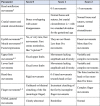Monochorionic vs Dichorionic Twins: Kanet Test vs Postnatal Neurodevelopment
- PMID: 32419862
- PMCID: PMC7221277
- DOI: 10.26574/maedica.2020.15.1.61
Monochorionic vs Dichorionic Twins: Kanet Test vs Postnatal Neurodevelopment
Abstract
The twin pregnancy is a risk pregnancy, being associated with a series of fetal and neonatal complications when compared to singleton pregnancies. Ultrasound assessment of the fetal brain is mandatory in the prenatal screening for fetal, congenital and acquired anomalies. Fetal neurosonography is useful in the prenatal diagnosis of cerebral anomalies, combining ultrasonography with fetal ultrasound. In this study, we assessed the Kanet score in two populations of pregnant women with dichorionic twin pregnancies (DC twin) (n=67) and monochorionic twin pregnancies (MC twin) (n=24). In the two groups we included pregnancies with normal fetal growth and pregnancies with discordant fetal growth (DC twin) and selective intrauterine reatriction (MC twin). For both groups, we assessed the antenatal Kanet score during three visits and compared the results with the neurodevelopment immediately after birth up to the two-year-old children. The calculation of the average values of the Kanet score for dichorionic pregnancies revealed normal, maximal average values at all three visits, for all fetuses, no matter if they had normal growth or discordant growth. At the first and third visit, we observed statistically significant differences between the average Kanet scores in DC twins with discordant growth vs. DC twins with normal growth. The analysis of average values of the Kanet score in the group of MC twin pregnancies revealed statistically significant differences between monochorionic twins with discordant growth vs. twins with normal growth at all three visits (p=0.0001), with average values between 17.30 and 19.62 being deemed normal. Amiel-Tison score was used as a standard tool for the neurological assessment both immediately after birth and for children up to two years of age.
Figures






Similar articles
-
Predictive value of maternal serum placental growth factor levels for discordant fetal growth in twins: a retrospective cohort study.BMC Pregnancy Childbirth. 2024 Jan 2;24(1):10. doi: 10.1186/s12884-023-06212-1. BMC Pregnancy Childbirth. 2024. PMID: 38166739 Free PMC article.
-
Outcome following selective fetal reduction in monochorionic and dichorionic twin pregnancies discordant for structural, chromosomal and genetic disorders.Aust N Z J Obstet Gynaecol. 2013 Apr;53(2):114-8. doi: 10.1111/ajo.12071. Aust N Z J Obstet Gynaecol. 2013. PMID: 23577786
-
Ultrasound in twin pregnancies.J Obstet Gynaecol Can. 2011 Jun;33(6):643-656. doi: 10.1016/S1701-2163(16)34916-7. J Obstet Gynaecol Can. 2011. PMID: 21846456 Review.
-
Parameters associated with outcome in third trimester monochorionic diamniotic twin pregnancies.J Obstet Gynaecol Can. 2010 May;32(5):429-434. doi: 10.1016/S1701-2163(16)34495-4. J Obstet Gynaecol Can. 2010. PMID: 20500950
-
Ultrasound in twins: dichorionic and monochorionic.Semin Perinatol. 2013 Oct;37(5):348-58. doi: 10.1053/j.semperi.2013.06.013. Semin Perinatol. 2013. PMID: 24176159 Review.
Cited by
-
Vitamin D status in women with dichorionic twin pregnancies and their neonates: a pilot study in China.BMC Pregnancy Childbirth. 2021 Apr 8;21(1):279. doi: 10.1186/s12884-021-03707-7. BMC Pregnancy Childbirth. 2021. PMID: 33832462 Free PMC article.
References
-
- Bot M, Burnei-Rusu A, Zamfirescu V, et al. Hemodynamic And Neurological Changes In Twin-to-Twin Transfusions. Proceedings of the 5th Congres of SRUOG 2017, FiLOdiritto Editore 2017. 2017.
-
- Royal College of Obstetricians and Gynaecologists. Management of Monochorionic Twin Pregnancy. BJOG. 2016.
-
- Chauhan SP, Scardo JA, Hayes E, et al. Twins: prevalence, problems, and preterm births. Am J Obstet Gynecol. 2010;203:305. - PubMed
-
- Pharoah POD. Dundar Y. Monozygotic twinning, cerebral palsy and congenital anomalies. Human Reproduction Update. 2009;6:639–648. - PubMed
-
- Merz E, Abramowicz JS. 3D/4D Ultrasound in Prenatal Diagnosis: Is it Time for Routine Use? Clin Obstet Gynecol. 2012;1:336–351. - PubMed
Publication types
LinkOut - more resources
Full Text Sources
